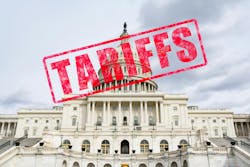Remain Calm Over Tariff Concerns Says ISM
With massive confusion about how to react to tariffs, ISM experts offer some insights. (The following is an excerpt from the article.)
The panel:
- Thomas W. Derry, ISM CEO
- Jim Fleming, CPSM, CPSD, Manager, Product Development and Innovation
- Paul Archiopoli, C.P.M., CPSD, CPIM, CMFGE, Subject Matter Expert
- Michelle Rohlwing, MBA, Manager, Product Development, Innovation and Learning
What’s your read on the current environment, and is there anything to add regarding mitigation strategies?
Derry: What’s old is new again. The “anti-tariff” playbook is well known and somewhat limited:
(1) Buy ahead — and there’s lots of evidence, including ISM data, showing that happened beginning in December
(2) “share” the tariff with the supplier, or more likely, get the supplier to reduce prices to offset the tariff — always a tough sell
(3) offset the cost of tariffs elsewhere in the business,
(4) move to a supplier in a tariff-exempt country, though not many of those remain,
(5) find a tariff-exempt substitute, and
(6) pass the cost to the customer. ISM reports indicate that passing costs is not being tried not so much to consumers, but more from suppliers to buyers.
Rohlwing: Even though the first major tariff in the U.S. was the Tariff Act of 1789, tariffs have been around for centuries to try to generate revenue and protect domestic industries. However, the volatility that has been created recently tends to create a pressure-cooker environment for supply chain professionals.
The best strategy is for supply chain professionals to remain calm and do their best to collaborate and be creative with solutions over the end-to-end supply chain. Having multiple solution scenarios prepared can be helpful to be agile in today’s volatility. Either way, the emerging technology available today will help them to be prepared and agile.
Fleming: Tariffs have been the roller coaster of economic uncertainty in the past few months. But they are not new. Supply chains are adapting to oscillations, using their experiences from past tariff turmoil and the post-COVID-19 environment. Supply chain professionals may be a bit stressed, but corporations are looking to and depending on them to seize the day. Our profession has evolved strategically to tackle enormous challenges. Practitioners should look through the lens of business leaders — and create solutions that enable winning.
Archiopoli: Jim is spot on. The current economic environment is turbulent, but working in procurement and supply chain has always been (and always will be) filled with challenges. But as the old saying goes, “Every cloud has a silver lining.” I have been in and around supply chain for the better part of 50 years and have never seen a workforce of better qualified, credentialed and equipped people with productivity tools that, until recently, were unimaginable. Such examples include advanced planning systems, PO automation, real-time tracking, warehouse automation and holistic decision-making — all combined with amazing capability growth in data analytics and the technology that enables it. This combination of talent and technology fuels my unwavering optimism for the future of supply chains.
